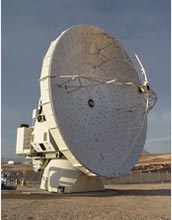|

Press Release 09-021
First North American Antenna Enables the ALMA Observatory to Do Its Thing

ALMA is on its way to developing observational capabilities with resolution 10 times that of the current state of the art
February 6, 2009
Astronomers today celebrated the formal acceptance of the first North American antenna by the Joint ALMA Observatory. ALMA, the Atacama Large Millimeter/submillimeter Array, is a gathering armada of short-wavelength radio telescopes whose combined power will enable astronomers to probe with unprecedented sharpness phenomena and regions that are beyond the reach of visible-light telescopes. The observatory is being assembled high in the Chilean Andes by a global partnership. With ALMA, astronomers will study the universe, the molecular gas and tiny dust grains from which stars, planetary systems, galaxies and even life are formed. ALMA will provide new insights into the formation of stars and planets and will reveal distant galaxies in the early universe, which we will see as they were over 10 billion years ago. The 12-meter-diameter antenna delivered today is the first of 25 being provided by North America's ALMA partners, whose efforts are led by the National Radio Astronomy Observatory and supported by the U.S. National Science Foundation (NSF) in cooperation with the National Research Council of Canada and the National Science Council of Taiwan. The antenna was manufactured by General Dynamics SATCOM Technologies. The acceptance comes just weeks after the first ALMA antenna--produced under the direction of the National Astronomical Observatory of Japan on behalf of ALMA's East Asian partners--was handed over to the observatory. "These ALMA antennas are technological marvels," said ALMA Director Thijs de Graauw. "They are more precise and more capable than any ever made. Their performance in the harsh winds and temperatures of our high-altitude site bodes well for the observatory's future." A single 12-meter antenna's dish is bigger than the largest optical telescope's reflective mirror, but to match the sharpness achieved by an optical telescope, a millimeter-wavelength dish would have to be impossibly large, miles across. ALMA will combine signals from dozens of antennas spread across miles of desert to synthesize the effective sharpness of such a single, gigantic antenna. The process, called "interferometry," involves analysis of the ways in which the signals coming from each antenna interfere with one another. "This is a major milestone for the ALMA project," explained Philip Puxley, NSF's ALMA program manager. "With two antennas now on site, we begin the real work of combining signals from them. We are advancing toward ALMA's ultimate goal of surpassing by tenfold existing technology in this area for sharper resolution, sensitivity and image quality." ALMA officials expect the pace of antenna acceptance to accelerate. "We have nine North American antennas on site already," said Adrian Russell, NRAO's ALMA project director. "Following handover of Number Three, we plan to get one through the test procedure each month. Additional North American antennas will be arriving in Chile at a rate of one every two months, and General Dynamics is on track to complete delivery of these systems within days of the original schedule." The antennas, which each weigh about 100 tons, can be moved to different positions in order to reconfigure the ALMA telescope. This repositioning will be carried out by two custom-designed transporters, each of which is some 33 feet wide, 66 feet long, and has 28 wheels. When completed early next decade, ALMA will have a total of 66 antennas, with an option for further expansion, provided by partners in North America, Europe and East Asia. The first European antennas, produced under the auspices of the European Organization for Astronomical Research in the Southern Hemisphere are scheduled to begin arriving early this year. The ALMA Project is a partnership between the scientific communities of East Asia, Europe and North America with Chile. ALMA is supported in North America by NSF in cooperation with the National Research Council of Canada and the National Science Council of Taiwan. ALMA construction and operations are led on behalf of North America by the National Radio Astronomy Observatory, which is operated under cooperative agreement by Associated Universities, Inc.
-NSF-

Media Contacts
Lisa-Joy Zgorski, NSF (703) 292-8311 lisajoy@nsf.gov
John Stoke, North American ALMA Outreach Program Officer, NRAO (434) 244-6896 jstoke@nrao.edu
Program Contacts
Philip John Puxley, NSF (703) 292-7835 ppuxley@nsf.gov
Adrian Russell, North American ALMA Project Director, NRAO (434) 296-0229 arussell@nrao.edu
Related Websites
National Radio Astronomy Observatory: http://www.nrao.edu

The National Science Foundation (NSF) is an independent federal agency that supports fundamental research and education across all fields of science and engineering. In fiscal year (FY) 2009, its budget is $9.5 billion, which includes $3.0 billion provided through the American Recovery and Reinvestment Act. NSF funds reach all 50 states through grants to over 1,900 universities and institutions. Each year, NSF receives about 44,400 competitive requests for funding, and makes over 11,500 new funding awards. NSF also awards over $400 million in professional and service contracts yearly.
 Get News Updates by Email Get News Updates by Email
Useful NSF Web Sites:
NSF Home Page: http://www.nsf.gov
NSF News: http://www.nsf.gov/news/
For the News Media: http://www.nsf.gov/news/newsroom.jsp
Science and Engineering Statistics: http://www.nsf.gov/statistics/
Awards Searches: http://www.nsf.gov/awardsearch/
| 

